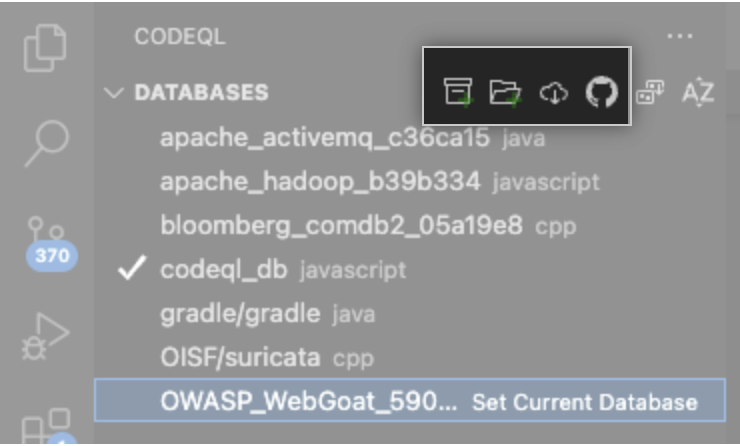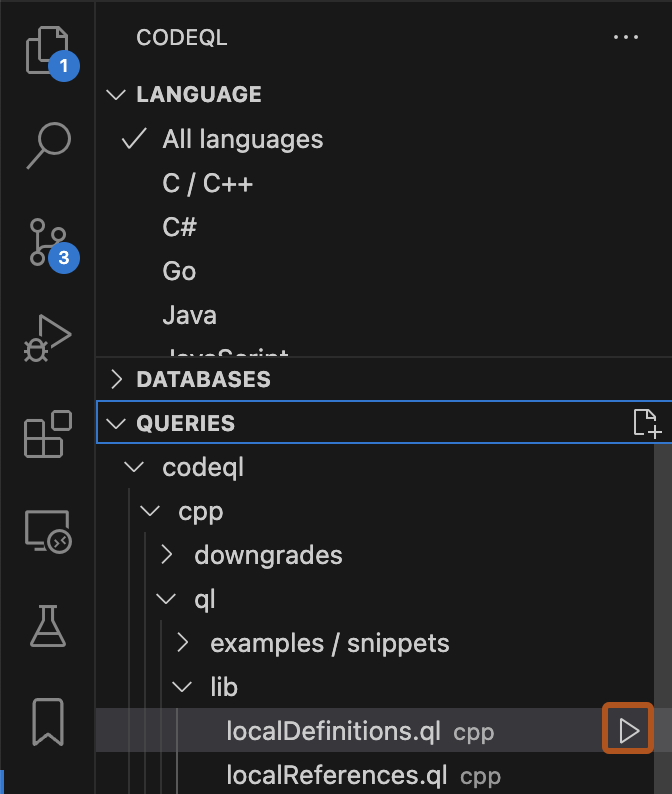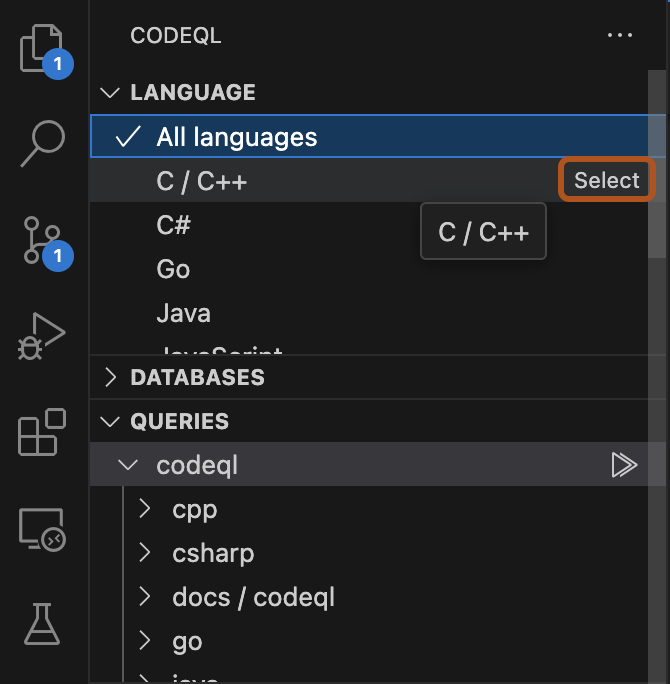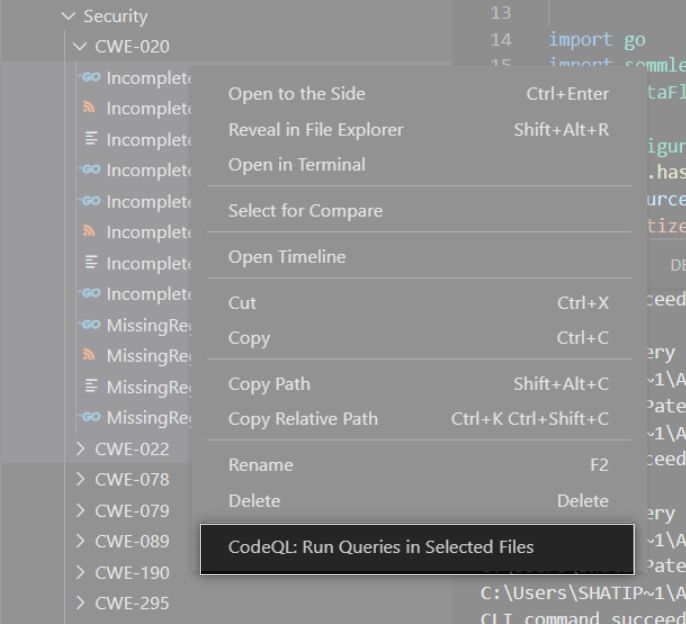Analyzing your projects¶
You can run queries on CodeQL databases and view the results in Visual Studio Code. This article explains how to get a CodeQL database and analyze it on your local machine. For information on running analysis at scale across many CodeQL databases, see “Running CodeQL queries at scale with multi-repository variant analysis.”
Choosing a database¶
To analyze a project, you need to add a CodeQL database for that project.
Open the CodeQL Databases view in the sidebar.
Hover over the Databases title bar and click the appropriate icon to add your database. You can add a database from a local ZIP archive or folder, from a public URL, or from a project’s URL on GitHub.com.

For more information about obtaining a local database, see below.
Once you’ve chosen a database, it is displayed in the Databases view. To see the menu options for interacting with a database, right-click an entry in the list. You can select multiple databases using Ctrl/Cmd+click.
Importing a local database¶
If you have a CodeQL database saved locally, as an unarchived folder or as a ZIP file, you can add it to Visual Studio Code. There are several ways to obtain a local CodeQL database.
To create a database with the CodeQL CLI, see “Creating CodeQL databases.”
To analyze a test database, add a
.testprojfolder to the Databases view. Test databases (that is, folders with a.testprojextension) are generated when you run regression tests on custom queries using the CodeQL CLI. If a query fails a regression test, you may want to analyze the test database in Visual Studio Code to debug the failure.For more information about running query tests, see “Testing custom queries” in the CodeQL CLI help.
Downloading a database from GitHub¶
GitHub stores CodeQL databases for over 200,000 repos on GitHub.com, which you can download using the REST API. The list of repos is constantly growing and evolving to make sure that it includes the most interesting codebases for security research.
You can check if a repository has any CodeQL databases available for download using the /repos/<owner>/<repo>/code-scanning/codeql/databases endpoint.
For example, to check for CodeQL databases using the GitHub CLI you would run:
gh api /repos/<owner>/<repo>/code-scanning/codeql/databases
This command returns information about any CodeQL databases that are available for a repository, including the language the database represents, and when the database was last updated. If no CodeQL databases are available, the response is empty.
When you have confirmed that a CodeQL database exists for the language you are interested in, you can download it using the following command:
gh api /repos/<owner>/<repo>/code-scanning/codeql/databases/<language> -H 'Accept: application/zip' > path/to/local/database.zip
For more information, see the documentation for the Get CodeQL database endpoint in the GitHub REST API documentation.
Filtering databases and queries by language¶
Optionally, to see databases containing a specific language and queries written for that language, you can apply a language filter using the language selector.
Creating a custom query¶
You can generate a query template for a specific language from the queries panel, then write your own code to quickly create a custom query.
Optionally, to create a custom query in an existing directory, in the sidebar, click the Queries title bar to expand the queries panel, then select the desired directory.
In the sidebar, hover over the Queries title bar, then click the Create query icon.

In the Command Palette, select the target language for your query. If you’ve chosen not to create your custom query in an existing directory, selecting a language will autogenerate a directory labeled
codeql-custom-queries-<language>, where<language>is the name of the selected language. A query template labeledexample.qlwill then be added to the existing or autogenerated directory.In the template, write your custom query, then save the file. Once your query is finished, you can run it from the queries panel.
Running a query¶
The CodeQL repository on GitHub contains lots of example queries. You can access any existing queries in your workspace through the queries panel.
In the sidebar, to expand the queries panel, click the Queries title bar.
To run a query against the selected database, hover over the desired query, then click the Run local query icon.

The CodeQL extension runs the query on the current database and reports progress in the bottom right corner of the application. When the results are ready, they’re displayed in the Results view.
If there are any problems running a query, a notification is displayed in the bottom right corner of the application. In addition to the error message, the notification includes details of how to fix the problem. For more information, see “Troubleshooting CodeQL for Visual Studio Code.”
Running multiple queries¶
You can quickly run multiple queries against the database you’ve selected using the queries panel or a single command.
Running all queries in a directory¶
You can easily run every query in a directory using the queries panel.
Running a selection of queries¶
You can run multiple queries with a single command.
Running a quick query¶
When working on a new query, you can open a “quick query” tab to easily execute your code and view the results, without having to save a .ql file in your workspace.
Open a quick query editing tab by selecting CodeQL: Quick Query from the Command Palette.
To run the query, use CodeQL: Run Query on Selected Database.
You can see all quick queries that you’ve run in the current session in the Query History view. Click an entry to see the exact text of the quick query that produced the results.
Once you’re happy with your quick query, you should save it in a CodeQL pack so you can access it later. For more information, see “About CodeQL packs.”
Running a specific part of a query or library¶
This is helpful if you’re debugging a query or library and you want to locate the part that is wrong.
Instead of using CodeQL: Run Query on Selected Database to run the whole query (the select clause and any query predicates), you can use CodeQL: Quick Evaluation to run a specific part of a .ql or .qll file.
CodeQL: Quick Evaluation evaluates a code snippet (instead of the whole query) and displays results of that selection in the Results view. Possible targets for quick evaluation include:
- Selecting the name of a CodeQL entity (such as a class or predicate) to evaluate that entity.
- Selecting a formula or expression with free variables to evaluate that formula or expression.
For example, in the following snippet, you could select the predicate name foo or the formula s = "bar" for quick evaluation.
predicate foo(string s) { s = "bar" }
Running a query on multiple databases¶
This is helpful if you want to test your query on multiple codebases, or find a vulnerability in multiple projects.
- Open a query (
.ql) file. - Right-click and select CodeQL: Run Query on Multiple Databases.
- From the dropdown menu, select the databases that you want to run the query on.
Viewing previous queries¶
To see the queries that you have run in the current session, open the Query History view.
The Query History contains information including the date and time when the query was run, the name of the query, the database on which it was run, and how long it took to run the query. To customize the information that is displayed, right-click an entry and select Rename. You can also filter the Query History view by language using the language selector. For more information, see “Filtering databases and queries by language.”
Click an entry to display the corresponding results in the Query Results view, and double-click to display the query itself in the editor (or right-click and select View Query). To display the exact text that produced the results for a particular entry, right-click it and select View Query Text. This can differ from View Query as the query file may have been modified since you last ran it.
To remove queries from the Query History view, select all the queries you want to remove, then right-click and select Delete.
Viewing query results¶
Click a query in the Query History view to display its results in the Results view.
Note
Depending on the query, you can also choose different views such as CSV, SARIF, or DIL format. For example, to view the DIL format, right-click a result and select View DIL. The available output views are determined by the format and the metadata of the query. For more information, see “CodeQL queries.”
Use the dropdown menu in the Results view to choose which results to display, and in what form to display them, such as a formatted alert message or a table of raw results.
To sort the results by the entries in a particular column, click the column header.
If a result links to a source code element, you can click it to display it in the source.
To use standard code navigation features in the source code, you can right-click an element and use the commands Go to Definition or Go to References. This runs a CodeQL query over the active file, which may take a few seconds. This query needs to run once for every file, so any additional references from the same file will be fast.
Note
If you’re using an older database, code navigation commands such as Go to Definition and Go to References may not work. To use code navigation, try unzipping the database and running
codeql database cleanup <database>on the unzipped database using the CodeQL CLI. Then, re-add the database to Visual Studio Code. For more information, see database cleanup in the documentation for CodeQL CLI.
Comparing query results¶
When you’re writing or debugging a query, it’s useful to see how your changes affect the results. You can compare two sets of results to see exactly what has changed. To compare results, the two queries must be run on the same database.
- Right-click a query in the Query History view and select Compare Results.
- A Quick Pick menu shows all valid queries to compare with. Select a query.
- The Compare view shows the differences in the results of the two queries.


